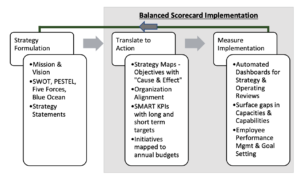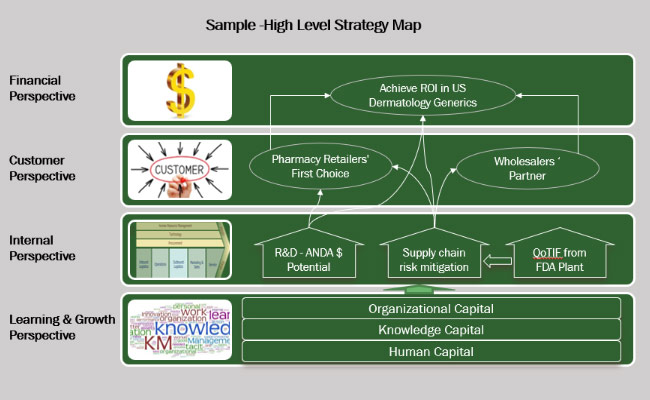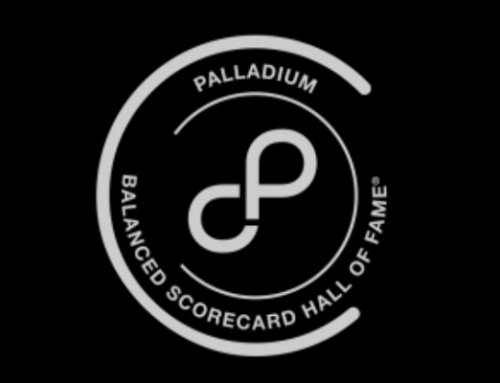When you come across a report titled “Strategy is Dead, Long Live Strategy” by one of the world’s leading strategy consulting firms, you better take note of it. However, when the opening sentence of that report contains “Far from it” – you know the intent behind the catchy title, and it’s a big sigh of relief for management consultants like us who focus on taking strategy from Boardroom to Front-line leveraging Balanced Scorecard (BSC) framework.
We all know that having just strategy in place will not help any organization, it needs to translate into action on the frontline. However, for a superior execution in the direction of achieving long-term goals, the strategy should not only be understood but also be believed in and actioned by the company’s middle management and frontline. Is there an established way to create that “Pull” from the whole organization? The answer is a resounding Yes, and the Balanced Scorecard (BSC) helps in achieving just that.
 As a part of BSC implementation through facilitated workshops, employees themselves break down corporate strategy and associated ambitious goals into objectives and then set long-term and short-term targets for themselves. In our long corporate and consulting career, we have yet to come across such an intuitive and comprehensive framework that bridges the gap between strategy and execution seamlessly. And we are not alone, BSC is now one of the most widely practiced management frameworks, boasting an adoption rate of more than 50% amongst Fortune 1,000 companies as well as The Balanced Scorecard concept was selected by the editors of Harvard Business Review as one of the most influential management ideas of the past 75 years.
As a part of BSC implementation through facilitated workshops, employees themselves break down corporate strategy and associated ambitious goals into objectives and then set long-term and short-term targets for themselves. In our long corporate and consulting career, we have yet to come across such an intuitive and comprehensive framework that bridges the gap between strategy and execution seamlessly. And we are not alone, BSC is now one of the most widely practiced management frameworks, boasting an adoption rate of more than 50% amongst Fortune 1,000 companies as well as The Balanced Scorecard concept was selected by the editors of Harvard Business Review as one of the most influential management ideas of the past 75 years.
The Balanced Scorecard (BSC) was developed by Dr. Robert S. Kaplan of Harvard University and Dr. David P. Norton as a framework for measuring organizational performance using a more balanced set of performance measures. Now the system has evolved over the years into a fully integrated strategic management system to ‘Translate Strategy into Action’. In our experience, BSC implementation helps organizations:
Translate strategy into action for frontline – Execution
 Balanced Scorecard uses Strategy Map to translate strategy into action. Strategy Map is a tool to convert strategy into a visual representation of the cause-and-effect relationships of important value-creating components of a strategy. The value-creating components with associated aspirations are shown as Strategic Objectives in a strategy map e.g. “Pharmacy Retailer’s First Choice” in the strategy map below.
Balanced Scorecard uses Strategy Map to translate strategy into action. Strategy Map is a tool to convert strategy into a visual representation of the cause-and-effect relationships of important value-creating components of a strategy. The value-creating components with associated aspirations are shown as Strategic Objectives in a strategy map e.g. “Pharmacy Retailer’s First Choice” in the strategy map below.
Strategy Maps are first created at the Strategic Business Unit (SBU) level and then for each unit of the SBU e.g. Marketing, Operations, SCM, HR, etc. A typical way to create maps is to carry out workshops and promote the active participation of middle management. The workshops allow the middle management team to realize the importance of their tasks and their critical role in executing strategy. This process also helps in empowering the staff and taking decision-making right into the hands of doers. Thereafter, Strategy Maps become an excellent visual tool to align, communicate with, and involve frontline executives.
Row the boat in the same direction – (Alignment)
The “cause and effect” relationships between strategic objectives clearly establish how each business unit is an “Internal Client” for the other business unit, and the need for business units to collaborate to reach long-term goals. Isn’t it common business sense? Yes, of course, it is, and that is why BSC is very intuitive. The key lies in the rigor applied in developing strategic business objectives in a room with all participants creating an environment of co-ownership and bringing alignment.
ZERO distraction – (Focus)
The exercise of the team themselves setting three-to-five-year goals for business units with intermediate monthly/ quarterly targets brings one hundred percent focus on achieving those targets – in other terms, effective focused execution becomes the key. In addition, selecting only strategic initiatives, to achieve the goals, with clearly defined accountabilities and commensurate budgets helps rationalize initiatives, optimize resource allocation, and keep the organization focused on delivering.
Fail fast and change to win- (Measurement)
The cascading of strategic objectives and related Key Performance Indicators (KPIs) enables the creation of performance dashboards focused on strategy implementation, and once the organization starts using them for operational reviews, suddenly, the strategy implementation becomes measurable. With clarity about direction and measurements in place, teams will be able to identify issues, and failed strategies, and will be able to course-correct the direction quickly toward winning.
Future-proof organization – (Prepare for the Future)
A typical BSC has four “Perspectives”, and one of them is “Learning & Growth” which focuses on building desired intangible capital i.e. organization capital, knowledge capital, and human capital, to achieve long-term goals and prepare the organization for the future. The linking of targets for each strategic objective in the other three Perspectives helps surface those internal capabilities & capacities that an organization needs to strengthen for long-term success.
Keep the performance management system balanced – (Balanced)
Once the targets are established for each business unit based on strategic objectives, they can then be broken down and cascaded to employees to build related KPIs for objectively measuring performances. Balancing KPIs between Lead vs Lag, Financial vs Non-Financial, Internal vs External, Subjective vs Objective, Short term vs Long term, ensures a robust, objective, and balanced employee performance management system.

